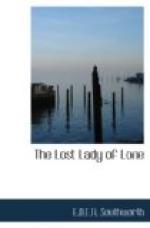The country side rang with the terrible story. And soon the telegraph wires flashed it all over the kingdom.
The coroner hastened to the castle, inspected the corpse, and ordered that everything should remain untouched. He then empanelled a jury for the inquest, whose first session was held in the chamber of death, from which the suffering daughter of the deceased banker had been tenderly removed.
Such among the guests who were not detained as witnesses, found themselves at liberty to depart. But very few availed themselves of the privilege. They preferred to stop and see the end of the inquest.
Skillful and experienced detectives were summoned by telegraph from Scotland Yard, London, and arrived at the castle about midnight.
The house was placed in charge of the police while the investigation was pending.
But the materials for the formation of a decided verdict seemed very meagre.
A careful examination of the body showed that the banker had been killed by one mortal blow inflicted by a blunt and heavy instrument that had crushed in the skull. The instrument was searched for, and soon found in a small but very heavy bronze statuette of Somnes that used to stand on the bedroom mantel-piece; but was now picked up from the carpet, crusted with blood and gray hair. But the miscreant who had held that deadly weapon, and dealt that mortal blow, could not be detected.
Investigation further brought to light that an extensive robbery had been committed. From the banker’s person his diamond-studded gold watch, chain, and seals, his gold snuff-box, set with emeralds, a heavy cornelian seal ring set in gold, and his diamond studs and sleeve buttons were taken. A patent safe, which stood in his room, and contained valuable documents as well as a large amount of money, had been broken open, the documents scattered, and the money carried off.
Yet no trace of the robber could be found.
The broken safe was the only piece of “professional” burglary to be seen anywhere about the house. The fastenings on every door and every window were intact.
The most plausible theory of the murder was, that some burglar, or burglars, attracted and tempted by the rumor of almost fabulous treasure then in the castle in the form of wedding offerings to the bride, had gained access to the building, and penetrated to the upper chambers, where, finding the banker still up and awake, they had killed him by one fell blow, to prevent discovery.
True, the priceless wedding presents had not been disturbed. They still blazed in their open caskets upon the drawing-room table—a splendid spectacle. But then they had been guarded all through the night by two faithful men-servants armed with revolvers and seated at the table under a lighted chandelier. It was supposed that the robbers, seeing this lighted and guarded room, had crept past it and mounted to the banker’s chamber to pursue their nefarious purpose there; that simple robbery was their first intention, but being seen by the watchful banker, they had instantly killed him to prevent his giving the alarm.




